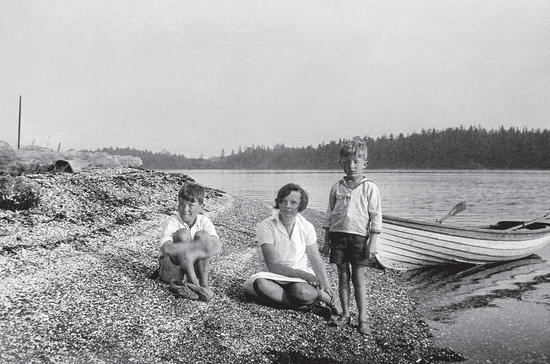Shiners
I left the children lying on their stomachs on the float, fishing for shiners with thread and a bent pin. Shiners are little glittering fishes that like to congregate under wharfs or floats. They are thin, but almost round in profile.
When I rowed back later the children all started shouting to me as soon as I was within ear-shot.
“Mine did it first! Mine did it first! It did too, Jan.” That was Peter’s voice.
I finally made myself heard. “If Peter’s did, whatever it did, first—then let him tell me, whatever it did, first.”
“My fish borned a baby,” he brought out triumphantly.
“Mine kept borning and borning them,” added John with scorn. “I just squeezed it.”
“Anyway, it’s perfectly true,” said Jan, “and they can swim right away. We’ll show you.”
I waited while they baited up their pins with bits of sea-worm, and lay down to catch more shiners—dangling the bait in front of the seeking mouths. I sat there full of superior knowledge. I have several times caught salmon that had been feeding heavily among the brit, and have had them regurgitate a minnow that was quite able to swim away; pressed it again in getting the hook out—and another small Jonah had made the world. I would wait until they showed me, and then I would explain to them the habits of fish.

They waited until they had each caught a shiner, then crouched there waiting for the miracle to happen.
“Squeeze them,” finally ordered Jan.
They squeezed them . . . From the vent of each shiner came forth a perfectly formed silver baby. They were slim and narrow, not round and deep like their mothers. The second they were put in the water they darted to the bottom—to the weeds and safety. John kept on squeezing his, and his fish went on borning babies just as he had said. But each next baby was more transparent than the last; and they began to look like vague little ghosts with all their inner workings showing through. When you dropped them in the water they seemed all bewildered—and in seconds the big shiners closed in and swallowed them at a gulp, and eagerly waited around for more. I stopped John then, and explained that they were not ready to be born yet. That their mother probably let only one out each day, when it was properly finished and had all its instincts and was able to fend for itself in the big sea. Undoubtedly—now that I knew—these shiner babies were being born all the time, at certain seasons. Perhaps their mothers were wise and only borned them in the dark night—then tiny phosphorescent streaks would dart for the seaweed. Then the awful thought reared its head—did the mothers know their own babies? Or did the babies have to elude the tigerish pounce of their own mother? It didn’t bear thinking about.
When we got back to Little House in the fall, I would find out from the “Encyclopædia Britannica (1885),” just what it had to say about all this. Perhaps, for a change, I’d be able to tell it something it didn’t know. After all, “Encyclopædia Britannica (1885)” states quite calmly, in black print, that malaria comes from the bad night air. Then I remembered my own little lecture, which fortunately had never been delivered. I conceded in my mind that we all make mistakes.
“Encyclopædia Britannica (1885)” . . . Yes, it knew all about viviparous fish—these shiners, as we called them, are a kind of rock perch. They and many others of that species are viviparous.
